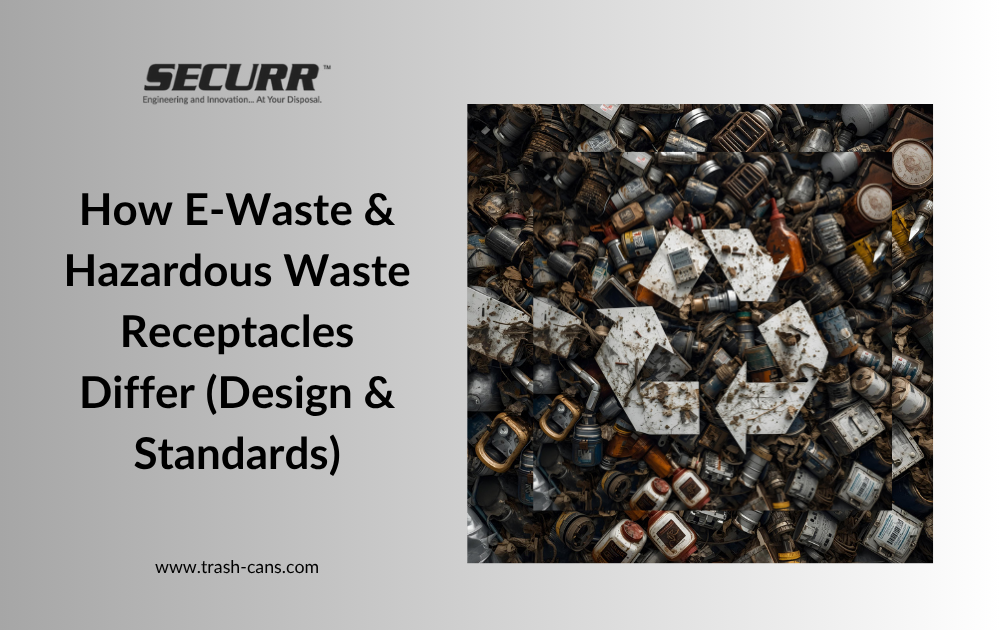How E-Waste & Hazardous Waste Receptacles Differ (Design & Standards)
Posted by Securr Blogger on
For any trash can manufacturer, understanding the difference between e-waste and hazardous-waste receptacles is critical. Though both deal with specialized waste streams, they are designed to meet different safety, compliance, and functional requirements.
1. Understanding the Waste Streams
E-Waste
E-waste (electronic waste) includes discarded electronics such as computers, phones, monitors, and printers. These devices contain both valuable recoverable materials (gold, copper, aluminum) and toxic elements (lead, mercury, cadmium).
Most regions regulate e-waste under electronics-recycling or “universal waste” programs, focusing on safe storage and transportation to certified recyclers.
Hazardous Waste
Hazardous waste includes materials that are toxic, flammable, corrosive, or reactive—like solvents, lab chemicals, batteries, or medical sharps. Their handling is tightly controlled under federal and state laws (e.g., EPA’s Resource Conservation and Recovery Act – RCRA, and OSHA workplace standards).
2. Design & Construction Differences
Materials & Durability
E-waste bins are generally built from powder-coated or galvannealed steel to withstand daily use and resist corrosion. They prioritize durability and a clean, professional appearance suitable for public or office settings.
Hazardous-waste receptacles require specialized containment—such as double-walled construction, chemical-resistant linings, and fire-rated materials—to prevent leaks, ignition, or chemical reactions.
Access & Security
E-waste receptacles often include secure deposit chutes or doors to protect sensitive electronics and prevent unauthorized removal.
Hazardous-waste containers, meanwhile, emphasize sealing and control—lockable lids, venting mechanisms, and tamper-evident closures to minimize exposure and maintain regulatory compliance.
Labeling & Identification
Proper labeling is critical.
-
E-waste bins are marked for electronics recycling and may include universal recycling symbols or custom graphics.
-
Hazardous-waste receptacles must display mandated labels like “Hazardous Waste—Do Not Dispose in Regular Trash,” and use regulated color codes (e.g., red for flammable, yellow for biohazard).
3. Regulatory Standards
E-Waste
E-waste collection is guided primarily by safe accumulation and transport requirements. Containers must ensure protection against weathering and unauthorized access. The goal is to make recycling easy and secure.
Hazardous Waste
Hazardous-waste management falls under EPA, OSHA, and DOT rules, requiring proper labeling, containment, and tracking of waste from generation through disposal (“cradle-to-grave” compliance). Receptacles must be durable, sealed, and inspected regularly to prevent releases or spills.
Accessibility & Compliance
Both receptacle types should follow ADA standards, ensuring accessible height, reach range, and usability in public facilities.
4. Implications for Trash-Can Manufacturers
Designing receptacles for different waste streams demands precision. Manufacturers should:
-
Define the target waste type — e-waste or hazardous waste — early in design.
-
Choose materials for durability and chemical compatibility.
-
Incorporate secure, ergonomic deposit mechanisms.
-
Ensure compliance with EPA, OSHA, and local regulations.
-
Label and color-code clearly for end-user safety and convenience.
-
Offer customization — branding, signage, or modular components — to serve diverse facility needs.
These practices distinguish a high-quality trash-can manufacturer that prioritizes safety, sustainability, and long-term usability.
E-Waste Receptacle Design in Practice
Trash-can manufacturers can look to commercial examples for guidance.
For instance, Securr’s e-waste collection bins include two models — EW01 and EW06 — that demonstrate how secure, durable e-waste receptacles can meet modern facility needs.
Both models feature:
-
Corrosion-resistant steel construction for longevity in high-traffic or public areas.
-
Lockable deposit chutes that prevent tampering or removal of electronics.
-
Powder-coat finishes to resist chemicals, moisture, and abrasion.
-
ADA-compliant design for accessibility and ease of use.
These design features represent best practices for e-waste receptacle manufacturing — blending durability, security, and regulatory compliance.
5. Summary
While e-waste and hazardous-waste receptacles may seem similar, their design goals and safety standards are fundamentally different.
E-waste bins prioritize security and recyclability, while hazardous-waste containers emphasize containment and regulatory compliance.
For trash-can manufacturers, mastering these distinctions ensures that every receptacle—whether for electronics or industrial waste—meets modern safety, accessibility, and sustainability standards.
Contact Securr for Professional-Grade Waste Solutions:
📞 888-671-7066 | ✉️ sales@securr.com

